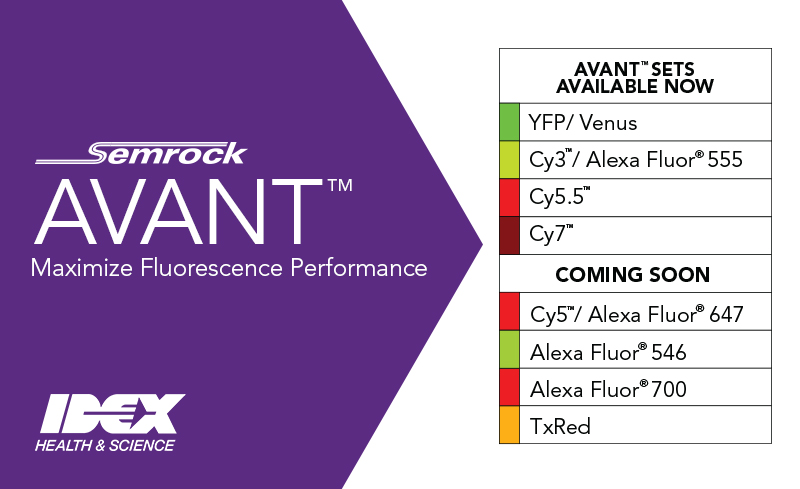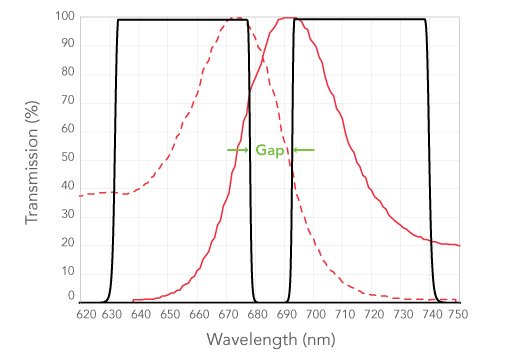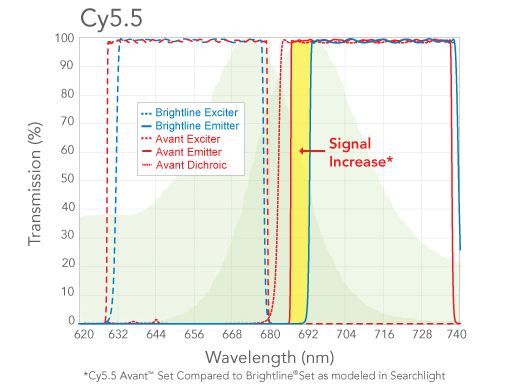
Each member of the Avant Filter Set Family provides significant improvement in fluorescence performance for its corresponding short Stokes Shift fluorophore. Here’s the rationale behind this development, and how it was achieved.
Rationale
A fluorescent filter set consists of the following:
- The excitation filter, which limits the range of wavelengths of excitation light
- The dichroic beamsplitter, which reflects the excitation light towards the sample and transmits the longer wavelength emission light towards the detector
- The emission filter, which passes a limited range of wavelengths of the emitted fluorescence to the detector
In a fluorescence filter set, the excitation passband is located over the excitation spectrum for the fluorophore, and the emission passband is located over the emission spectrum of the fluorophore.
Our ability to set the two passbands for best results depends on the Stokes Shift, the separation in nm between the peak excitation and peak emission wavelengths of the fluorophore. A number of very popular fluorescent probes have small Stokes Shifts, less than 3% of their wavelength. Though the excitation and emission passbands for these probes would normally be placed close together, this has historically not been the case.
Instead, one sees the more typical pattern for these short Stokes Shift fluorophores shown in Fig. 1. The so-called Gap between the long-wavelength excitation passband edge and the short-wavelength emitter passband edge is located quite asymmetrically with respect to the crossover point for the fluorophore, where the normalized excitation and emission curves cross.

This asymmetry pushes the emitter passband out to longer wavelengths, and the result is less emission light capture by the emission filter and reduced filter set performance. The Gap has been difficult to reduce for two reasons: (1) A decreased Gap results in higher levels of excitation light bleedthrough, i.e., excitation light reflected from the specimen plane into the emission filter, and (2) manufacturing variability limits our ability to place the two spectral edges in the narrow Gap without risking collision between the two filter edges at deeper OD.
Because this performance deficit holds for a number of popular fluorophores, there is systematic underperformance of corresponding filter sets over the industry. As IDEX Health & Science has recently made strides in improving its Semrock optical filter coating performance and metrology capabilities, it set out to improve the performance of filter sets for short Stokes Shift fluorophores. This has resulted in the Avant Filter Set Family.
Paradigm
Three steps were used to work around the limitations described above:
- The spectral edges of the two proximate passband edges for exciter and emitter were significantly steepened from their values in standard filter sets.
- Once the edges were steepened, the two proximate edges were moved closer together.
- Deep complementary blocking (OD 10, Design Specification) was implemented in both exciter and emitter to suppress excitation light bleedthrough.
Recent key, proprietary advances at Semrock made this possible:
- Steeper spectral edges were made possible by improvements in control of the filter coating process.
- The placement of the spectral edges with increased accuracy was made possible by the Precise Edge Placement capability, which results in tightened statistical distribution of edge positions.
- The KolaDeep™ Spectral Measurement System, with its ability to measure OD down to OD 8 or 9 and to resolve edges steeper than 0.2% of the edge wavelength, was used to confirm spectral edge characteristics.
Results
An example is shown in Fig. 2, which shows the modeled increase in fluorescence emission signal for the Cy5.5 fluorophore.

Modeling was performed using the SearchLight simulation tool using measured spectra of the new filter sets, summarized in the table below. The fluorescence improvement is significant, as shown in the rightmost column, and the excitation light bleedthrough (shown in the column to the left of the fluorescence percent increase) has been effectively eliminated.
| Fluorescent Probe | Excitation Source | Filter Set | Fluorescence Signal × 106 | Excitation Light Bleedthrough × 109 | Fluorescence Signal Improvement with Avant |
|---|---|---|---|---|---|
| Venus | 525 nm LED (X-Cite Turbo) | LED-Venus-A | 3.07 | 2.70 | 16% |
| Avant Venus-YFP | 3.56 | < 10-4 | |||
| Cy3 | 575 nm LED (X-Cite Turbo) | Cy3-4040C | 1.56 | 4.10 | 46% |
| Avant Cy3 | 2.28 | < 10-4 | |||
| Cy5.5 | 655 nm Lumiled LXM3-PD01 | Cy5.5-C | 1.76 | 1.20 | 31% |
| Avant Cy5.5 | 2.30 | < 10-4 | |||
| Cy7 | 740 nm CoolLED | LED-Cy7-A | 4.28 | 5.20 | 26% |
| Avant Cy7 | 5.38 | < 10-4 |
Early results from a Semrock optical filter customer using Cy5.5 showed an increase of some 40% in fluorescence signal over background when the Cy5.5 Avant filter set was used in comparison to an incumbent filter set.
Summary
The Avant Filter Set Family delivers improved fluorescence signal and signal-to-noise ratio to applications areas that prioritise efficiency, speed, and performance. In addition, Avant technology is now available for custom filter and filter set design. We welcome inquiries from all OEM developers of fluorescence-based tools.































